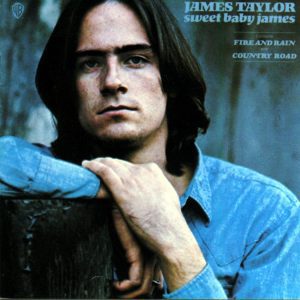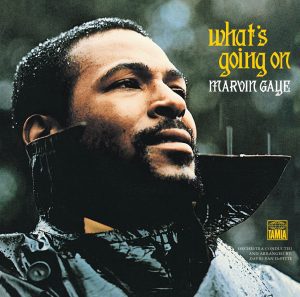[powerpress]
The Album Effect episode 17 discusses Sweet Baby James by James Taylor, The Suburbs by Arcade Fire, What’s Going On by Marvin Gaye, and People Who Can Eat People Are the Luckiest People in the World by Andrew Jackson Jihad. Plus new upcoming single, The Choices of John Still by Conner Cherland, featuring the Rare Occasions, and more. Hosted by Manny, Nick, Dave, and Britt.
Conner Cherland’s single “The Choices of John Still” is set for release on August 17, 2018. Check out Conner Cherland at: connercherland.com
Have an album you’d like us to review?
Let us know on Instagram @thealbumeffect or Twitter @thealbumeffect
Episode 17 Albums:
Sweet Baby James (1970)
James Taylor
The singer/songwriter movement of the 1970s produced a number of memorable albums, but it’s first notable release may well have been James Taylor’s Sweet Baby James. The five-time Grammy winner would go on to sell millions of records throughout his storied career, but his road to success was filled with a number of setbacks.
Having written his first song on guitar at age 14, Taylor never had trouble picking up instruments, but mental health issues and drug dependency caused a litany of problems throughout much of his early adulthood. After a move to New York City in hopes of forming a successful band proved futile, his father brought him home to North Carolina to get him into a treatment program, after which he went to London to record his first solo album.
Taylor’s first work, a self-titled debut released on The Beatles’ Apple Records label, didn’t make much of an impact, but his second album, Sweet Baby James, would become his big breakthrough. Recorded in California for a tiny percentage of its original budget, the album featured Taylor’s acoustic guitar and warm vocals, as well as piano accompaniment from popular musician Carole King.
Not an immediate success, Sweet Baby James had slow sales at first, until the release of the breakthrough single “Fire and Rain.” Hailed as a folk-rock classic, the song written about Taylor’s struggles to overcome drug addiction and cope with the suicide of a close friend resonated with many listeners, helping push the previously stalled album up the charts. With its title dedicated to Taylor’s nephew, who also shared his first name, Sweet Baby James spearheaded a bevy of soft rock releases in the early 1970s. Many felt that the style spoke to a generation overwhelmed by the tumultuous era of the 1960s and looking toward quieter, introspective works.
The Suburbs (2010)
Arcade Fire
Arcade Fire founders, Josh Deu and Win Butler first met in high school, though it was during their college years that the acclaimed indie band was born. When the duo was first rehearsing at McGill University, they met third member – and Butler’s future wife – Régine Chassagne, while she was also studying music at the school. They recorded a few demos, assembled a group of other musicians and began performing live – however, the initial lineup broke up just a year later. Eventually, a new group was assembled without Deu, who left to continue his education, and Arcade Fire released their first full-length, Funeral, an album acclaimed for its atmospheric art rock.
Further accolades were to come with the band’s third studio album, The Suburbs. With a sound inspired by artists like Depeche Mode and Neil Young, The Suburbs won numerous awards, including the 2011 Grammy for Album of the Year and the BRIT’s Best International Album award. The Suburbs’ lyrics were inspired by, well, the suburbs, as they were gleaned from Butler’s youth on the outskirts of Houston, Texas. It was very important to the band to create an album that stood as a complete work, in which songs often reference each other and pull together as a cohesive whole.
Arcade Fire also used a unique recording process in which each song was first recorded on tape, pressed to vinyl, and then played back to be re-digitized. Butler describes the final output as something akin to “a photograph of the vinyl,” expressing his desire to use the digital medium as means of archiving a physical product.
What’s Going On (1971)
Marvin Gaye
Soul legend, Marvin Gaye came from the most meager of roots, spending his early years enduring a violent home life in the public housing projects of Southwest Washington D.C. He credited his mother’s belief in his talents with helping him to endure difficult times through music, having started singing at church at just 4-years old.
Encouraged to pursue a career in entertainment after performing in a school play, Gaye originally had no interest in becoming an R&B star, instead seeking to perform jazz music and standards. Gaye went on to become part of a number of groups and worked as a session musician, but things changed significantly in 1960, when he was discovered by Motown president Berry Gordy after performing at a holiday party. Signed to Motown subsidiary Tamla, he recorded a number of successful duets, but grew increasingly unhappy with the stringent control Motown had over his career.
Fate would change his fortunes in 1970 when Motown songwriter Al Cleveland penned a track based on an incident of police brutality witnessed by Four Tops singer Renaldo Benson. The Four Tops chose not to record the song, and it was offered to Gaye, who revised what would become the title track for What’s Going On. Gordy originally refused to release it on Motown, considering it too political for commercial radio – to which Gaye responded by going on strike from recording for the label.
Eventually released in 1971, the song hit Number One on the R&B charts in less than a month and became Motown’s fastest-selling single. Gaye took 10 days to record the rest of the album, a concept work written from the perspective of a Vietnam vet returning home to a country filled with rampant injustice. Named Rolling Stone’s Album of the Year, What’s Going On received tremendous critical acclaim. Echoes of Gaye’s work can still be heard in current music with Mos Def, Nas, Lupe Fiasco, and many others all having sampled tracks from the landmark release.
People Who Can Eat People Are the Luckiest People in the World (2007)
Andrew Jackson Jihad
Sean Bonnette formed Andrew Jackson Jihad with Ben Gallaty when he was just a teenager. The duo wrote macabre-themed folk punk, sung with Bonnette’s rushed, nasal delivery and backed by Gallaty’s frantic upright bass. Though the band originally had a third member, drummer Justin James White, he left soon after forming, and they went on to have a series of guest musicians fill various roles throughout their 14-year history.
In recent years, the band has distanced themselves somewhat from their past, changing their irreverent name in 2016 to simply AJJ. Bonnette has said that he no longer wanted to use a word he felt was disrespectful to use as a non-Muslim, and didn’t really want the association with the former US President either.
AJJ’s second album, 2007’s People Who Can Eat People Are the Luckiest People in the World, takes its name from a line in a Kurt Vonnegut book, which is itself a reference to Barbara Streisand’s song “People.” All of the songs feature primarily an acoustic guitar and upright bass combo, but branch out a bit from the simplicity of their debut by adding electric guitar, horns, and banjo on some tracks. Bonnette’s vocals have been compared to those of The Mountain Goats’ John, and his on this release run the gamut from satirical humor to nihilistic self-hatred.
















